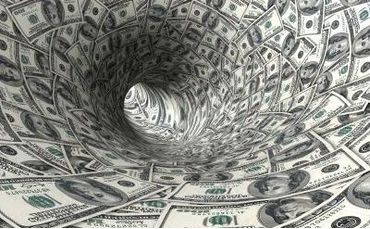
In today’s day and age, the concept of what money actually represents has faded somewhat from public consciousness. Money that was based on gold or silver used to have intrinsic value due to its precious metal content.
Nevertheless, these days comparatively few people have any notion that the so-called fiat or paper currencies that they use as money on a daily basis in their countries are really only worth the value of the paper used in their production once public faith in the issuer fails.
Some countries like Germany found this out the hard way, as their population’s savings were decimated by inflation and people turned to burning the almost worthless paper currency as fuel, rather than attempting to spend it.
While the above situation may seem somewhat extreme, the reality is that for some time now, the paper currency used in society has only been backed by nothing more than the “full faith and credit” of the issuer. In the end of the article you will find links to other big and entertaining stories of forex frauds.
How Fiat Currencies Came to be Accepted
Precious metals like gold and silver have played an important historical role as currencies of exchange since ancient times. Nevertheless, the idea of fixing the value of a nation’s paper currency to the price of gold seems to have originated with the British whose nation was the first to adopt the so-called Gold Standard in 1821.
Basically, Britain discovered that by fixing the value of its printed paper currency, the Pound Sterling, to the price of gold, it could use printed money backed by gold held in reserve to pay off its debts and otherwise engage in international commerce.
Other major countries like Germany, France, the United States and Canada followed the British example in the 1870’s. After such paper currencies issued by major nations were first introduced, their exchange rates relative to one another were first fixed to the price of gold.
Inflationary Risks of Leaving the Gold Standard
The stresses and costs of the World Wars in the early part of the 20th century caused many involved countries like Britain to start printing money without having the gold to back it up. By effectively leaving the Gold Standard, this had the rather unfortunate result of hyperinflation, as the Germans soon found out after the start of World War I.
The German hyperinflationary period came to a head in the early 1920’s, during which time its paper currency became almost worthless as a result of dramatic overprinting by its government and the German people suffered the almost complete loss of their savings.
This hyperinflation scenario has also been observed in numerous other nations since that desperate and highly unsettling time for the German people.
While the fundamental conditions sometimes differ, the common risk factor usually involves the nation straying from the Gold Standard. Its government then starts printing more money without the hard assets to back it up. Eventually, this fact becomes obvious and the paper currency’s value goes into free fall as people start losing faith in the currency and the government issuing it.
Of course, this phenomenon suitably illustrates the ever present risk of allowing countries to use fiat currencies that are just paper debt instruments rather than having hard currencies backed with real and valuable assets like gold or silver.
The Bretton Woods System
Just before the end of WWII, the major nations of the world agreed at the Bretton Woods conference of 1944 to peg their currencies to the value of the U.S. Dollar. The Dollar in turn had its value fixed to the price of gold at $35 per ounce.
The so-called Bretton Woods system of fixed exchange rates provided for a period of considerable stability among the exchange rates of the major European nations in the post WWII period. This in turn led to substantial growth in international trade and general prosperity.
Nevertheless, even that gold-linked exchange rate system started to unravel in 1971 after the U.S. Dollar, the system’s lynchpin, was unilaterally removed from the Gold Standard. This surprise move by then-President Richard Nixon was allegedly done to quell speculative hoarding of gold.
As was previously seen in Germany to a somewhat lesser extend, a period of severe inflation in the United States predictably ensued.
The Fiat Currency Fraud Scenario
Basically, fiat currencies could well be considered the biggest forex fraud ever committed on the people of the world as they have now grown to accept virtually worthless pieces of paper in exchange for their labor, instead of assets of real intrinsic value like gold. If so, the fiat currency scam has now been perpetrated on almost all populations of the developed world.
Furthermore, the issuance of fiat currencies has allowed governments to overspend to an increasingly ridiculous degree, often without any real accountability to their citizens.
In such countries, the excessive printing of fiat currencies and the virtually inevitable resulting inflation has been gradually whittling away at individuals’ attempts to accumulate wealth as the value of their nation’s currency eventually falls and prices increase.
Other entertaining and spectacular forex frauds:
Learn about Fabrice Tourre, the brain behind Goldman Sachs’ one billion dollar fraud.
Related Articles
- Forex vs Crypto: What’s Better For Beginner Traders?
- Three Great Technical Analysis Tools for Forex Trading
- What Does Binance Being Kicked Out of Belgium Mean for Crypto Prices?
- Crypto Traders and Coin Prices Face New Challenge as Binance Gives up its FCA Licence
- Interpol Declares Investment Scams “Serious and Imminent Threat”
- Annual UK Fraud Audit Reveals Scam Hot-Spots
Forex vs Crypto: What’s Better For Beginner Traders?
Three Great Technical Analysis Tools for Forex Trading
Safest Forex Brokers 2025
| Broker | Info | Best In | Customer Satisfaction Score | ||
|---|---|---|---|---|---|
| #1 |
|
Global Forex Broker |

BEST SPREADS
Visit broker
|
||
| #2 |
|
Globally regulated broker |

BEST CUSTOMER SUPPORT
Visit broker
|
||
| #3 |
|
Global CFD Provider |

Best Trading App
Visit broker
|
||
| #4 |
|
Global Forex Broker |

Low minimum deposit
Visit broker
|
||
| #5 |
|
Global CFD & FX Broker (*Don’t invest unless you’re prepared to lose all the money you invest. This is a high-risk investment and you should not expect to be protected if something goes wrong. Take 2 mins to learn more) |

ALL-INCLUSIVE TRADING PLATFORM
Visit broker
|
||
| #6 |
|
Global Forex Broker |

Low minimum deposit
Visit broker
|
||
| #7 |
|
CFD and Cryptocurrency Broker |

CFD and Cryptocurrency
Visit broker
|
||
|
|
|||||
Forex Fraud Certified Brokers
Stay up to date with the latest Forex scam alerts
Sign up to receive our up-to-date broker reviews, new fraud warnings and special offers direct to your inbox


